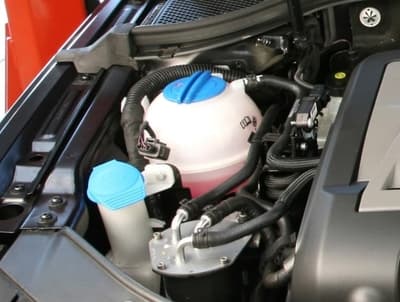How to top up engine coolant
Every car needs engine coolant to keep it running smoothly and you should check this at least twice a year, ideally in early Summer and the Winter.

We’ve put together some information on how to check your coolant and identify any problems.
Where is my engine coolant tank?
The engine coolant tank is not always in the same position in all cars, so if you are unsure where your tank is please refer to your vehicle handbook. The tank will look similar to the one in the image above with the coloured liquid in the bottom.
How do I check the engine coolant?
Your engine needs to be cold to check the engine coolant, so leave it to cool down for at least 2 hours or overnight if possible. Unscrewing the engine coolant cap while the engine is hot can be dangerous, pressure inside the tank can push steam out very quickly and you may scald your hand, so be careful and use gloves to be on the safe side.
When the engine is cool check if the coolant level is between the minimum and maximum indicators on the outside of the tank. If the coolant level is low, your engine may start to overheat and this will need topping up urgently.
If you need to top up with new coolant please make sure to use the correct coolant mixture. This can be purchased from motoring supply shops and petrol stations. To top up the coolant unscrew the coolant cap slowly to release any pressure and top up to the maximum level but not above. If you overfill the tank it can cause more pressure in the tank and potentially force the cap off or the seals to break. Please make sure the cap is screwed tightly back on when you finish.
What does the engine coolant do?
The engine coolant helps to keep the engine cool and as it passes through the engine it is transferred to your car’s radiator, where it continues to cool down via air flow as the car moves.
When the vehicle’s engine is stopped you will often hear a fan, this helps to cool down the engine and reduces the temperature of the coolant.
When should I change the engine coolant?
Manufacturers guidance on changing engine coolant varies, but if you notice discolouring or rust in the coolant mixture it will need to be changed immediately.
Can I use water instead of engine coolant?
This is a frequently asked question, yes you can top up with just water, but you should only do this in an emergency to enable you to get to a garage.
Engine coolant contains antifreeze, so diluting with water will lower the boiling point and the coolant will stop to work efficiently.
How will I know if there is an engine coolant problem?
The thermometer on your dashboard will show an increase in normal temperature, which is a good indicator that your engine is starting to overheat.
You may also get a thermometer warning light on your dashboard.
Related: Car dashboard warning lights
Both these signs are an indication that the engine coolant level needs to be checked. If the level is low you will need to top up this immediately.
If your coolant level is frequently low you may have a leak, please check all seals, hoses and clamps.
Residue on the tank could also indicate a leak.
If you identify a leak, you will need to change the faulty part and this could include the whole coolant tank.
What should I do if my engine overheats?
If your engine is overheating, you should pull over into a safe place as soon as possible and check the coolant levels, but please wait until your engine is cool to avoid scalding yourself. When the engine is cool you will get a more accurate reading. If the coolant level is low you will need to top up immediately, preferably don’t drive until you have topped up, so you may need to ask someone to bring water or coolant.
If the level is below the lower level indicator this could indicate a problem and you will need to take the car to a garage immediately or call out your breakdown service. Turning off the air conditioning can help reduce the strain on the engine while you drive to the garage.
Servicing at National
At National Tyres and Autocare, we offer a range of servicing packages. We offer either a Full Service, an Interim Service or an Oil and Filter Service. Regularly servicing can help identify problems with engine coolant and leaks. On an MOT Check if you have low engine coolant, you will still pass your MOT, however, it will be marked as an advisory.
Related: 5 vital car checks
Hope this information is helpful, but if you need further advice please speak to a technician in one of our National Tyres and Autocare branches.
Did you enjoy this blog post? |33 people found this review helpful



 Sign up for SPECIAL OFFERS
Sign up for SPECIAL OFFERS
